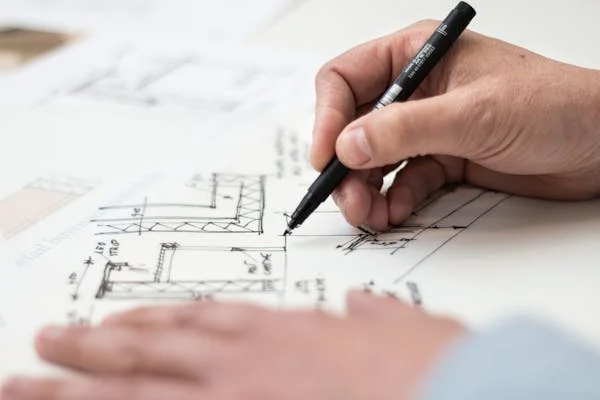Introduction
Nathalie Lunzwitz is an influential designer known for her sustainable and technologically advanced approach to architecture and digital art. Her work blends eco-conscious principles with the latest advancements in design and digital technology.
Early Influences and Inspirations
1. Rural Background
Nathalie Lunzwitz’s formative years were spent in the French countryside, where she developed an intimate relationship with nature. This connection with the natural environment is evident in her work, where organic shapes and materials from nature play a key role.
- Connection with Nature: Growing up surrounded by natural landscapes fostered a deep appreciation for environmental sustainability.
- Early Artistic Expression: Her childhood experiences inspired her to pursue a career that combines both art and nature.
2. Environmental Impact
Lunzwitz’s early exposure to the negative effects of industrialization on nature shaped her desire to use design as a way to promote environmental conservation.
- Rural Inspiration: Her rural upbringing led her to explore eco-friendly and sustainable design practices.
- Motivation for Sustainability: Focused on environmental preservation through design.
Understanding Sustainable Design
1. What is Sustainable Design?
Sustainable design involves creating products, systems, or buildings that minimize environmental impact and utilize resources efficiently. This philosophy has become central to Lunzwitz’s approach to design.
- Eco-Friendly Materials: Lunzwitz prioritizes recycled, organic, and biodegradable materials in her work.
- Energy Efficiency: Designs that promote energy-saving and renewable energy solutions.
2. The Importance of Sustainable Design
Lunzwitz believes that sustainable design is not just a trend but a necessary shift for the future of the design industry.
- Environmental Responsibility: Reducing carbon footprints through innovative materials and energy-efficient systems.
- Long-Term Benefits: Sustainability ensures that resources are used wisely for future generations.
Biomimicry: Drawing Inspiration from Nature
1. What is Biomimicry?
Biomimicry involves taking inspiration from nature’s time-tested patterns and strategies to solve human problems. This is a key principle in Lunzwitz’s work.
- Nature’s Efficiency: Nature’s strategies, such as energy-saving and water conservation, guide Lunzwitz’s designs.
- Mimicking Natural Processes: Lunzwitz integrates biomimicry into architecture to create more efficient and sustainable structures.
2. Application in Design
Lunzwitz uses natural models in design, from structure to functionality, reducing waste and increasing performance.
- Shape and Form: Mimicking natural forms for greater efficiency.
- Ecological Harmony: Integrating ecological systems into architectural designs for better environmental integration.
Featured Project: The Living Building
An Overview of The Living Building
The Living Building, designed by Lunzwitz, is a prime example of sustainable architecture. The project combines green roofs, solar power, and water harvesting systems to create a building that is energy-efficient and self-sustaining.
| Feature | Description | Environmental Benefit |
| Solar Panels | Powers the building using solar energy. | Reduces reliance on non-renewable energy. |
| Green Roofs | Roofs with plant cover for insulation and air purification. | Improves air quality and supports local biodiversity. |
| Rainwater Harvesting | Collects rainwater for non-potable uses. | Decreases water consumption and waste. |
The Role of Technology in Sustainable Design
1. Integrating Technology with Sustainability
Technology is an essential component in Lunzwitz’s design process, allowing for efficient resource management and environmental monitoring. She uses digital tools to predict the long-term effects of design choices.
- 3D Modeling: Helps visualize and test designs before implementation.
- Energy Simulations: Uses software to simulate energy usage and optimize designs for minimal consumption.
2. Digital Tools for Efficiency
Lunzwitz employs a range of digital tools to help with sustainable design practices, ensuring her creations are both efficient and environmentally responsible.
- Advanced Simulations: Software to analyze the environmental impact of design options.
- Smart Systems: Integration of IoT systems for energy and water conservation.
Sustainability in Material Selection
1. Choosing the Right Materials
Material choice plays a vital role in Lunzwitz’s designs, and she favors sustainable, locally sourced, and recycled materials. This contributes significantly to reducing the carbon footprint of her projects.
- Eco-Friendly Materials: Selection of renewable and recyclable materials.
- Local Sourcing: Reduces transportation emissions and supports local economies.
2. The Impact of Material Choices
Using sustainable materials not only enhances the ecological performance of Lunzwitz’s designs but also promotes the importance of making conscious decisions in design.
- Durability and Longevity: Using materials that are durable ensures minimal waste.
- Recycling and Upcycling: Encourages the reuse of materials from previous projects.
Creating Digital Art for Environmental Awareness
1. The Intersection of Art and Sustainability
As a digital artist, Lunzwitz uses technology to explore and promote environmental awareness. Through interactive digital installations, she immerses audiences in eco-conscious experiences.
- Interactive Installations: Engages people in sustainability dialogues through art.
- Augmented Reality: Virtual environments to simulate sustainable futures and educate audiences.
2. Art as a Tool for Advocacy
Lunzwitz’s digital art is more than just aesthetic; it serves as a platform to advocate for environmental change.
- Raising Awareness: Art used to provoke thought about climate change and sustainability.
- Educational Experience: Encouraging viewers to consider their environmental impact.
Collaborating with Technology Companies
1. Partnerships with Major Tech Firms
Lunzwitz has collaborated with technology giants like Google and Autodesk to push the boundaries of sustainable design. Through these partnerships, she integrates cutting-edge tech solutions into her projects.
- Tech Collaboration: Working with Google on environmental tech initiatives.
- Sustainability at Scale: Using tech to implement sustainable designs on a global scale.
2. Advancing Sustainability through Innovation
These collaborations allow Lunzwitz to incorporate the latest tech innovations into sustainable design practices, making them more accessible to a larger audience.
- Global Impact: Reaching wider audiences through tech-driven sustainability.
- Innovation Focus: Continuously exploring new technologies to improve design efficiency.
The Influence of Nathalie Lunzwitzon Global Design Trends
1. Shaping Modern Design Principles
Lunzwitz’s innovative approach to design has inspired a wave of sustainability-focused trends across industries, influencing a range of design disciplines from architecture to fashion.
- Environmental Responsibility: Encourages designers to prioritize the planet’s future.
- Future-Oriented Designs: Designs built with long-term sustainability in mind.
2. Promoting Sustainable Design Worldwide
Her influence has encouraged designers globally to adopt sustainable practices, making green design a mainstream trend.
- Design Education: Pushing for sustainability to be a core subject in design curricula.
- Industry Influence: Challenging global industries to embrace eco-friendly innovations.
Notable Awards and Recognition
1. Recognition in Design
Lunzwitz’s work has garnered numerous awards from both design and environmental organizations, further solidifying her place as a leader in sustainable design.
- Design Awards: Recognized for her innovative, eco-friendly designs.
- Environmental Honors: Praised for her commitment to sustainability.
2. Industry Influence
Through her success, Lunzwitz has become a key figure shaping the future of sustainable design, influencing both young designers and established professionals.
- Impact on Young Designers: Inspires the next generation of eco-conscious creators.
- Global Industry Recognition: Gaining attention from major environmental and design organizations.
The Challenges of Sustainable Design
Overcoming High Costs
Sustainable design often comes with a higher initial cost. Lunzwitz tackles this challenge by demonstrating that long-term savings and environmental benefits justify the upfront investment.
- Initial Investment: Higher costs associated with green materials and technologies.
- Long-Term Savings: Reduced operational costs and increased efficiency.
Breaking Industry Resistance
Some industries are slow to adopt sustainable practices. Lunzwitz addresses this resistance by showing the clear advantages of sustainability, including cost savings and long-term resilience.
- Increased Adoption: Proving the viability of eco-friendly design.
- Changing Mindsets: Advocating for sustainability as a standard practice.
Educating Future Generations
1. Nathalie Lunzwitz Commitment to Teaching
A passionate advocate for education, Lunzwitz regularly conducts workshops and seminars to teach upcoming designers about sustainable design principles and practices.
- Workshops: Teaching sustainable design practices to future architects and designers.
- Lectures and Panels: Sharing knowledge through educational platforms.
2. Mentoring Future Designers
By mentoring young designers, Lunzwitz ensures that the next generation of creators continues her mission to make design more sustainable.
- Design Schools: Collaboration with universities to offer sustainable design programs.
- Global Influence: Expanding her reach by mentoring designers around the world.
Nathalie Lunzwitz Vision for the Future
1. Continuous Innovation
Looking ahead, Lunzwitz remains committed to advancing sustainable design through new technologies and materials. She aims to push the boundaries of how technology can be used to make designs more eco-conscious.
- Future Innovations: Exploring new technologies for eco-friendly design.
- Expanding Influence: Continuing to grow her impact on sustainable practices worldwide.
2. Commitment to a Greener Tomorrow
Lunzwitz’s long-term vision is to lead the charge in creating a more sustainable, green world through design and technology.
- Sustainability Goals: Creating designs that leave a positive legacy for future generations.
- Innovating for the Planet: Dedicated to reducing the environmental impact through every design decision.
Conclusion:
Nathalie Lunzwitz’s dedication to sustainable design and innovative solutions has reshaped the way we think about architecture and digital art. By combining nature’s principles with cutting-edge technology, she continues to inspire future generations of designers to prioritize eco-conscious practices. Her work demonstrates that sustainability is not only feasible but essential for the future of our planet. Through her teaching, collaborations, and impactful projects, Lunzwitz is ensuring that sustainable design will remain at the forefront of global creative industries for years to come.
In conclusion, Nathalie Lunzwitz is a true pioneer, pushing boundaries while staying rooted in the values of environmental stewardship and technological advancement. As the world moves towards a more sustainable future, her legacy will undoubtedly serve as a blueprint for the designers and artists who follow.
FAQs About Nathalie Lunzwitz
Who is Nathalie Lunzwitz?
A renowned architect and digital artist, Lunzwitz focuses on sustainable design by combining nature-inspired principles with technology.
What is sustainable design?
It reduces environmental impact by using resources efficiently, central to Lunzwitz’s work.
How does Nathalie Lunzwitz use technology?
She applies tools like 3D modeling and energy simulations for eco-friendly designs.
What is biomimicry in design?
It involves mimicking nature to solve design challenges, a technique Lunzwitz uses in her work.
What is The Living Building project?
A sustainable architecture project by Lunzwitz featuring green roofs and energy-efficient systems.
How has Nathalie Lunzwitz influenced modern design?
Her work inspires designers to adopt eco-friendly practices with innovative and sustainable designs.





